Weng-Fai Wong
Optimizing Neural Networks with Learnable Non-Linear Activation Functions via Lookup-Based FPGA Acceleration
Aug 23, 2025Abstract:Learned activation functions in models like Kolmogorov-Arnold Networks (KANs) outperform fixed-activation architectures in terms of accuracy and interpretability; however, their computational complexity poses critical challenges for energy-constrained edge AI deployments. Conventional CPUs/GPUs incur prohibitive latency and power costs when evaluating higher order activations, limiting deployability under ultra-tight energy budgets. We address this via a reconfigurable lookup architecture with edge FPGAs. By coupling fine-grained quantization with adaptive lookup tables, our design minimizes energy-intensive arithmetic operations while preserving activation fidelity. FPGA reconfigurability enables dynamic hardware specialization for learned functions, a key advantage for edge systems that require post-deployment adaptability. Evaluations using KANs - where unique activation functions play a critical role - demonstrate that our FPGA-based design achieves superior computational speed and over $10^4$ times higher energy efficiency compared to edge CPUs and GPUs, while maintaining matching accuracy and minimal footprint overhead. This breakthrough positions our approach as a practical enabler for energy-critical edge AI, where computational intensity and power constraints traditionally preclude the use of adaptive activation networks.
Enabling Energy-Efficient Deployment of Large Language Models on Memristor Crossbar: A Synergy of Large and Small
Oct 21, 2024Abstract:Large language models (LLMs) have garnered substantial attention due to their promising applications in diverse domains. Nevertheless, the increasing size of LLMs comes with a significant surge in the computational requirements for training and deployment. Memristor crossbars have emerged as a promising solution, which demonstrated a small footprint and remarkably high energy efficiency in computer vision (CV) models. Memristors possess higher density compared to conventional memory technologies, making them highly suitable for effectively managing the extreme model size associated with LLMs. However, deploying LLMs on memristor crossbars faces three major challenges. Firstly, the size of LLMs increases rapidly, already surpassing the capabilities of state-of-the-art memristor chips. Secondly, LLMs often incorporate multi-head attention blocks, which involve non-weight stationary multiplications that traditional memristor crossbars cannot support. Third, while memristor crossbars excel at performing linear operations, they are not capable of executing complex nonlinear operations in LLM such as softmax and layer normalization. To address these challenges, we present a novel architecture for the memristor crossbar that enables the deployment of state-of-the-art LLM on a single chip or package, eliminating the energy and time inefficiencies associated with off-chip communication. Our testing on BERT_Large showed negligible accuracy loss. Compared to traditional memristor crossbars, our architecture achieves enhancements of up to 39X in area overhead and 18X in energy consumption. Compared to modern TPU/GPU systems, our architecture demonstrates at least a 68X reduction in the area-delay product and a significant 69% energy consumption reduction.
NOVA: NoC-based Vector Unit for Mapping Attention Layers on a CNN Accelerator
May 07, 2024Abstract:Attention mechanisms are becoming increasingly popular, being used in neural network models in multiple domains such as natural language processing (NLP) and vision applications, especially at the edge. However, attention layers are difficult to map onto existing neuro accelerators since they have a much higher density of non-linear operations, which lead to inefficient utilization of today's vector units. This work introduces NOVA, a NoC-based Vector Unit that can perform non-linear operations within the NoC of the accelerators, and can be overlaid onto existing neuro accelerators to map attention layers at the edge. Our results show that the NOVA architecture is up to 37.8x more power-efficient than state-of-the-art hardware approximators when running existing attention-based neural networks.
Integrating Deep Learning and Synthetic Biology: A Co-Design Approach for Enhancing Gene Expression via N-terminal Coding Sequences
Feb 20, 2024Abstract:N-terminal coding sequence (NCS) influences gene expression by impacting the translation initiation rate. The NCS optimization problem is to find an NCS that maximizes gene expression. The problem is important in genetic engineering. However, current methods for NCS optimization such as rational design and statistics-guided approaches are labor-intensive yield only relatively small improvements. This paper introduces a deep learning/synthetic biology co-designed few-shot training workflow for NCS optimization. Our method utilizes k-nearest encoding followed by word2vec to encode the NCS, then performs feature extraction using attention mechanisms, before constructing a time-series network for predicting gene expression intensity, and finally a direct search algorithm identifies the optimal NCS with limited training data. We took green fluorescent protein (GFP) expressed by Bacillus subtilis as a reporting protein of NCSs, and employed the fluorescence enhancement factor as the metric of NCS optimization. Within just six iterative experiments, our model generated an NCS (MLD62) that increased average GFP expression by 5.41-fold, outperforming the state-of-the-art NCS designs. Extending our findings beyond GFP, we showed that our engineered NCS (MLD62) can effectively boost the production of N-acetylneuraminic acid by enhancing the expression of the crucial rate-limiting GNA1 gene, demonstrating its practical utility. We have open-sourced our NCS expression database and experimental procedures for public use.
HyperSNN: A new efficient and robust deep learning model for resource constrained control applications
Aug 17, 2023Abstract:In light of the increasing adoption of edge computing in areas such as intelligent furniture, robotics, and smart homes, this paper introduces HyperSNN, an innovative method for control tasks that uses spiking neural networks (SNNs) in combination with hyperdimensional computing. HyperSNN substitutes expensive 32-bit floating point multiplications with 8-bit integer additions, resulting in reduced energy consumption while enhancing robustness and potentially improving accuracy. Our model was tested on AI Gym benchmarks, including Cartpole, Acrobot, MountainCar, and Lunar Lander. HyperSNN achieves control accuracies that are on par with conventional machine learning methods but with only 1.36% to 9.96% of the energy expenditure. Furthermore, our experiments showed increased robustness when using HyperSNN. We believe that HyperSNN is especially suitable for interactive, mobile, and wearable devices, promoting energy-efficient and robust system design. Furthermore, it paves the way for the practical implementation of complex algorithms like model predictive control (MPC) in real-world industrial scenarios.
DeepFire2: A Convolutional Spiking Neural Network Accelerator on FPGAs
May 09, 2023Abstract:Brain-inspired spiking neural networks (SNNs) replace the multiply-accumulate operations of traditional neural networks by integrate-and-fire neurons, with the goal of achieving greater energy efficiency. Specialized hardware implementations of those neurons clearly have advantages over general-purpose devices in terms of power and performance, but exhibit poor scalability when it comes to accelerating large neural networks. DeepFire2 introduces a hardware architecture which can map large network layers efficiently across multiple super logic regions in a multi-die FPGA. That gives more control over resource allocation and parallelism, benefiting both throughput and energy consumption. Avoiding the use of lookup tables to implement the AND operations of an SNN, prevents the layer size to be limited by logic resources. A deep pipeline does not only lead to an increased clock speed of up to 600 MHz. We double the throughput and power efficiency compared to our previous version of DeepFire, which equates to an almost 10-fold improvement over other previous implementations. Importantly, we are able to deploy a large ImageNet model, while maintaining a throughput of over 1500 frames per second.
Efficient Hyperdimensional Computing
Jan 26, 2023Abstract:Hyperdimensional computing (HDC) uses binary vectors of high dimensions to perform classification. Due to its simplicity and massive parallelism, HDC can be highly energy-efficient and well-suited for resource-constrained platforms. However, in trading off orthogonality with efficiency, hypervectors may use tens of thousands of dimensions. In this paper, we will examine the necessity for such high dimensions. In particular, we give a detailed theoretical analysis of the relationship among dimensions of hypervectors, accuracy, and orthogonality. The main conclusion of this study is that a much lower dimension, typically less than 100, can also achieve similar or even higher detecting accuracy compared with other state-of-the-art HDC models. Based on this insight, we propose a suite of novel techniques to build HDC models that use binary hypervectors of dimensions that are orders of magnitude smaller than those found in the state-of-the-art HDC models, yet yield equivalent or even improved accuracy and efficiency. For image classification, we achieved an HDC accuracy of 96.88\% with a dimension of only 32 on the MNIST dataset. We further explore our methods on more complex datasets like CIFAR-10 and show the limits of HDC computing.
Desire Backpropagation: A Lightweight Training Algorithm for Multi-Layer Spiking Neural Networks based on Spike-Timing-Dependent Plasticity
Nov 10, 2022Abstract:Spiking neural networks (SNN) are a viable alternative to conventional artificial neural networks when energy efficiency and computational complexity are of importance. A major advantage of SNNs is their binary information transfer through spike trains. The training of SNN has, however, been a challenge, since neuron models are non-differentiable and traditional gradient-based backpropagation algorithms cannot be applied directly. Furthermore, spike-timing-dependent plasticity (STDP), albeit being a spike-based learning rule, updates weights locally and does not optimize for the output error of the network. We present desire backpropagation, a method to derive the desired spike activity of neurons from the output error. The loss function can then be evaluated locally for every neuron. Incorporating the desire values into the STDP weight update leads to global error minimization and increasing classification accuracy. At the same time, the neuron dynamics and computational efficiency of STDP are maintained, making it a spike-based supervised learning rule. We trained three-layer networks to classify MNIST and Fashion-MNIST images and reached an accuracy of 98.41% and 87.56%, respectively. Furthermore, we show that desire backpropagation is computationally less complex than backpropagation in traditional neural networks.
Low Latency Conversion of Artificial Neural Network Models to Rate-encoded Spiking Neural Networks
Oct 27, 2022Abstract:Spiking neural networks (SNNs) are well suited for resource-constrained applications as they do not need expensive multipliers. In a typical rate-encoded SNN, a series of binary spikes within a globally fixed time window is used to fire the neurons. The maximum number of spikes in this time window is also the latency of the network in performing a single inference, as well as determines the overall energy efficiency of the model. The aim of this paper is to reduce this while maintaining accuracy when converting ANNs to their equivalent SNNs. The state-of-the-art conversion schemes yield SNNs with accuracies comparable with ANNs only for large window sizes. In this paper, we start with understanding the information loss when converting from pre-existing ANN models to standard rate-encoded SNN models. From these insights, we propose a suite of novel techniques that together mitigate the information lost in the conversion, and achieve state-of-art SNN accuracies along with very low latency. Our method achieved a Top-1 SNN accuracy of 98.73% (1 time step) on the MNIST dataset, 76.38% (8 time steps) on the CIFAR-100 dataset, and 93.71% (8 time steps) on the CIFAR-10 dataset. On ImageNet, an SNN accuracy of 75.35%/79.16% was achieved with 100/200 time steps.
Optimizing for In-memory Deep Learning with Emerging Memory Technology
Dec 01, 2021



Abstract:In-memory deep learning computes neural network models where they are stored, thus avoiding long distance communication between memory and computation units, resulting in considerable savings in energy and time. In-memory deep learning has already demonstrated orders of magnitude higher performance density and energy efficiency. The use of emerging memory technology promises to increase the gains in density, energy, and performance even further. However, emerging memory technology is intrinsically unstable, resulting in random fluctuations of data reads. This can translate to non-negligible accuracy loss, potentially nullifying the gains. In this paper, we propose three optimization techniques that can mathematically overcome the instability problem of emerging memory technology. They can improve the accuracy of the in-memory deep learning model while maximizing its energy efficiency. Experiments show that our solution can fully recover most models' state-of-the-art accuracy, and achieves at least an order of magnitude higher energy efficiency than the state-of-the-art.
 Add to Chrome
Add to Chrome Add to Firefox
Add to Firefox Add to Edge
Add to Edge